The ILM creative director and Jurassic‘s production visual effects supervisor talks dinosaurs and collaborating with Gareth Edwards.
By Mark Newbold
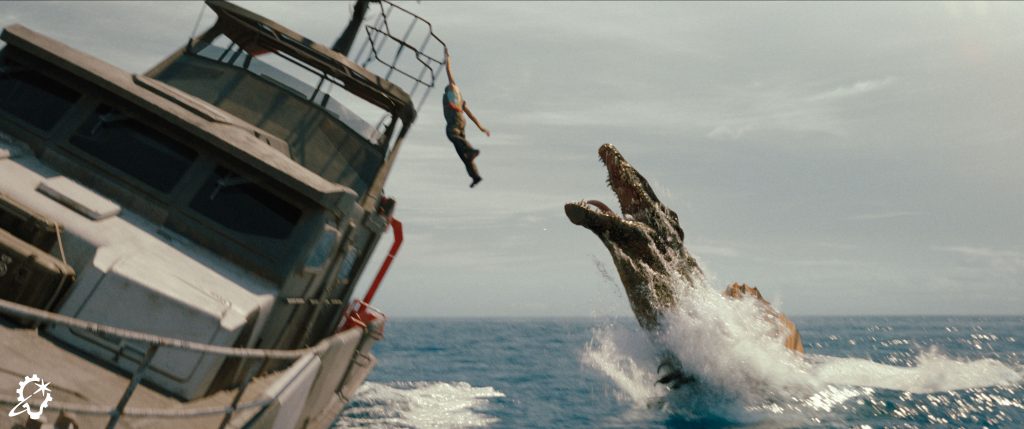
Jurassic World Rebirth (2025) has grabbed global audiences by the hand and pulled them back into the savage world of the Jurassic film series, three years after Jurassic World: Dominion (2022) completed the second Jurassic trilogy. Rebirth has also changed the direction of the franchise, focusing on the genetic heritage of the incredible dinosaur creations.
Taking place on the fictional island of Île Saint-Hubert in the Atlantic Ocean, Rebirth shows the terrifying cost of unchecked genetic manipulation as we meet familiar creatures, including the armored Ankylosaurus, the chicken-sized Compsognathus, the crested, acid-spitting Dilophosaurus, the aquatic Mosasaurus, the F-16-sized Quetzalcoatlus, and, of course, Tyrannosaurus rex (albeit a much beefier one than the classic Rexy).
Along with these classic creatures are new franchise stars Scarlett Johansson as Zora Bennett, Mahershala Ali as Duncan Kincaid, Jonathan Bailey as Dr. Henry Loomis, and Rupert Friend as Martin Krebs. Together, they encounter distinctly unfamiliar dinosaurs, including the enormous Distortus rex, the towering Titanosaurus, and the horrifying Mutadon. It’s a one-way trip for anyone visiting the island – but in the capable hands of director Gareth Edwards (Rogue One: A Star Wars Story [2016] and The Creator [2023]) and visual effects supervisor David Vickery (Jurassic World: Fallen Kingdom [2018], Jurassic World: Dominion, and Mission: Impossible – Rogue Nation [2015]), it’s exactly what was needed for a pulse-pounding adventure in the grand Jurassic style.
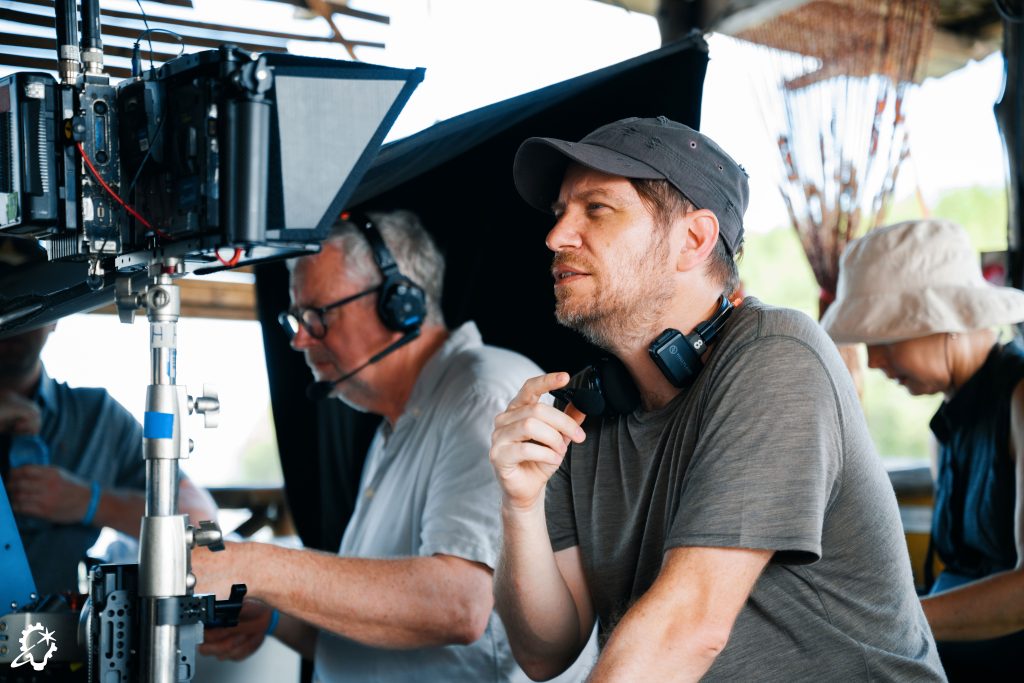
ILM.com had the chance to sit down with David Vickery to discuss the visual effects of Jurassic World Rebirth. We started by looking at how the visual effects field is viewed today compared to a decade ago, when Jurassic World (2015) broke box office records and made the world stare in awe at dinosaurs all over again.
“The visual effects industry has grown in many ways,” says Vickery. “There’s a lot more trust placed in us than there used to be, even 10 years ago. Back then, visual effects were seen as something of a necessary evil – but now we find ourselves much more readily accepted as a department on set. Nowadays, other departments – whether it’s hair, makeup, costumes, special effects, stunts – rely on visual effects to guide how to film something because they know how vital it is that the visual effects work properly at the end of the process. They want to make sure what they’re doing is conducive to how we’re going to work, and it always used to be the other way around, so that’s been a refreshing change.”
On the surface, the art of visual effects may appear to be made up of equal parts skill, ingenuity, knowledge, and creativity, but the field also requires a healthy dose of collaboration, as Vickery explains.
“Over the years, I’ve found myself not trying to figure out how to do visual effects but rather figure out how not to do visual effects, and, as best I can, enable people on set to get what they need. You rely on the expertise of the crew. The camera operators and special effects technicians might have been in the industry for 30 years, and at ILM, we’ve got a bunch of talented artists that are generalists by nature, so that level of trust in visual effects has definitely grown.
“There’s a narrative in the press about how everything is done in-camera,” Vickery adds. “Well, yeah, everything is shot in camera because you can’t ‘shoot’ visual effects. What you’re trying to capture is as many practical things on set as you can because you can’t go back and get it in post-production.”
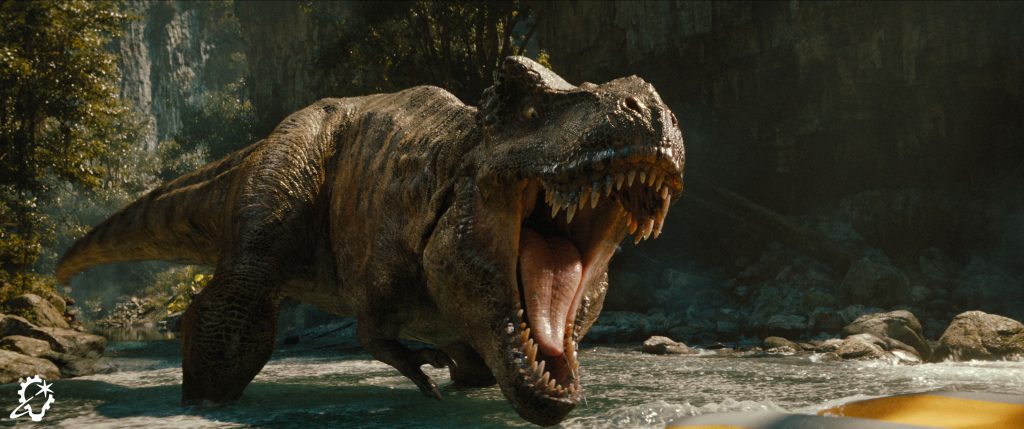
A veteran of three Jurassic adventures (three and a half if you include the 2019 short, Battle at Big Rock, directed by Colin Trevorrow), Vickery has worked with three directors (Trevorrow, J.A. Bayona on Fallen Kingdom, and Edwards), and that means differing styles and methods in bringing the dinosaurs to life.
“I find it interesting, the experiences I have with crews, directors, and producers who want to make their films in different ways,” he explains. “Colin relied heavily on animatronics for his films [Jurassic World and Jurassic World Dominion]. Gareth is much more comfortable with visual effects and wanted a consistency in his aesthetic by relying on effects for all the creatures and dinosaurs. On top of that, there’s a layer of what’s fashionable in movies at the moment. For a while, it was very ‘in’ to be shooting on green screen, or it was fashionable to use animatronics, and that’s what the public wanted to see. Now there’s a desire to see things filmed on location, and there’s an acceptance of visual effects, so filmmakers respond to that in the way they make their films. It’s interesting to see the evolution in how things are done.”
The style and flair shown by Gareth Edwards in his previous films – and his obvious affection for giants, as evidenced by Godzilla (2014) and Monsters (2010) – led producer Frank Marshall and executive producer Steven Spielberg to offer him Rebirth’s directorial seat in early 2024. And with that came a rare skill set for a major franchise film: a vast working knowledge and understanding of visual effects.
“Gareth’s a very distinctive filmmaker,” explains Vickery. “He comes from a visual effects background, so he truly understands how things work. He’s the type of filmmaker that creatively evolves his thought process as a project develops, so he’s totally happy to change his approach and defer some decision-making to later down the line. Visual effects is a great opportunity for him to do that, but he also likes reacting to natural things that happen on the day.”
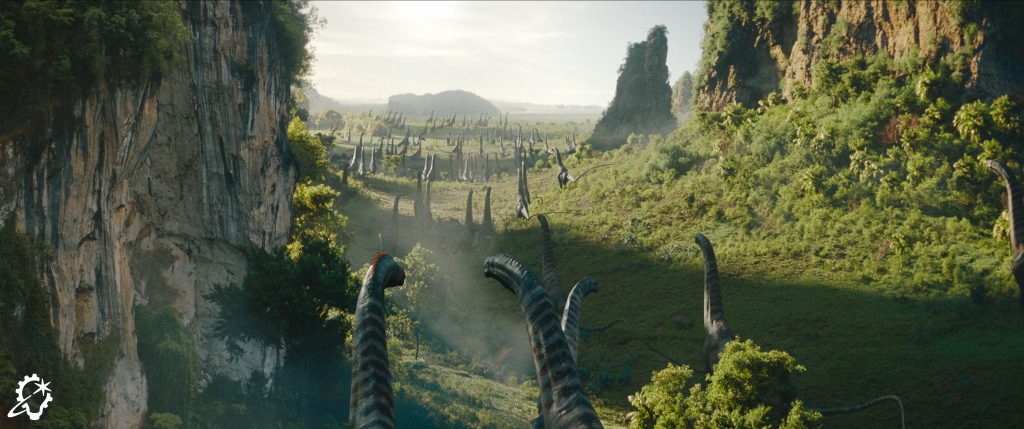
Along with his knowledge of effects, Edwards is also known for his guerilla filmmaking style, something Vickery would learn more about from an Oscar-winning special effects supervisor.
“We worked with Neil Corbould [special effects supervisor for 2000’s Gladiator and Edwards’s The Creator, among others] on Rebirth,” Vickery says, “and I spoke to Neil beforehand because I was trying to find out what Gareth is like, and he said Gareth shoots really long takes. I’d heard of 20-minute or 30-minute takes on Rogue One, but how do you plan for that? How do you rig special effects knowing that Gareth’s going to roll for 20 minutes? Neil said they put a load of stuff out there – loads of mortars, loads of pots, loads of bangs, loads of fires and squibs, and they fired them off. They gave him something to work with, and Gareth reacted to that. Gareth wants to be in the real world, to react to what’s in front of him, and then capture the best version of that.”
That drive to find the best moments, to allow the actors to add their own essence to their characters, and to rarely say “cut,” extends to the visual effects realm as well, where Vickery found Edwards was every bit as open to allowing ILM to find those moments.
“He’s very open with his creative briefs and gives ILM a lot of creative flexibility in how to work,” says Vickery. “He doesn’t look at something and say, ‘What’s wrong with this?’ At ILM, we look at something and try to understand how we can make it better, and I think that’s why we stand out in the visual effects field. We’re trying to figure out how things can be made better, and Gareth does the same. He looks at something and in his head it’s a 7 out of 10, but what do we have to do to make it a 10 out of 10? What do we have to do to make it an 11 out of 10? He’s always going to wonder what would happen if we pushed it a little bit more. Does it break, or is it better? He doesn’t want to leave any creative opportunities on the table.”
Edwards’s naturalistic style formed the bedrock of the film, giving Vickery and the ILM team an opportunity to do things differently, opting for realistic substance over easier, stylistic options.
“Gareth said early on that he never wanted to get into a situation where the dinosaur walks into shot, strikes a pose, and roars. That feels staged,” Vickery says. “When you photograph animals in nature, they do whatever they want, so there were a few golden rules that he gave us. We should never animate a dinosaur unless we had reference of a real animal to use. It didn’t have to be doing exactly what the dinosaur was doing in that moment because you can’t find real dinosaur animation reference, but it could be something like a large animal looking scared or startled. Gareth said if we do that, he wouldn’t question whether the animation or the intent of the performance was correct, so he was very good at not micromanaging.”
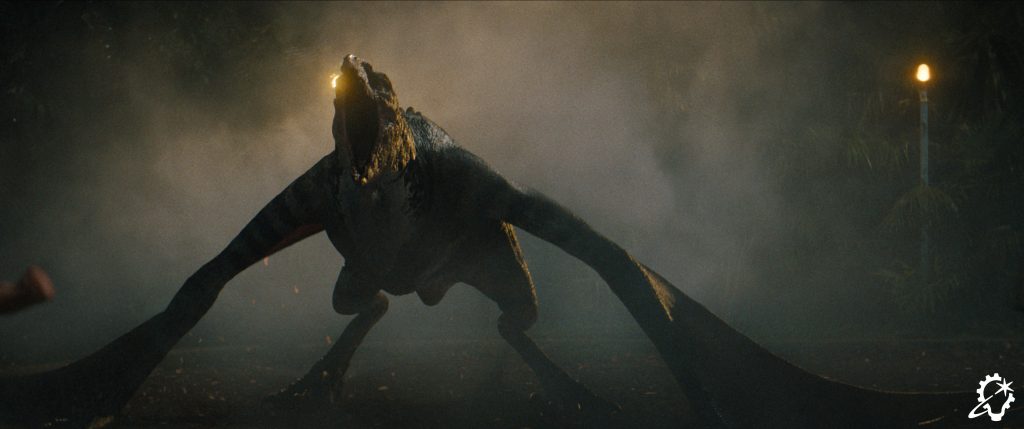
Another advantage of Edwards’s understanding of the effects tool kit was that it gave Vickery and his team a framework to build the film around before the work began.
“He would construct an edit for us, but because he understands visual effects, he also understands the possibilities of what the shots can be,” notes Vickery. “We often found that the first time you watched them, it was difficult to understand how he wanted the performances of the creatures to play out, but you started to work on it and put it together, and suddenly we were like, ‘Oh yeah, that really works, the timing here’s really good.’ That’s how his visual effects background plays to his strengths because he can see the finish line much more clearly in his head than most other creatives.”
With all the advantages of a director understanding one of the key elements of the production, the process of building the film forged on.
“The first process we go through is laying the shots out and blocking in very basic key frame animation,” says Vickery. “That process takes a long time because it’s all about getting the composition of the image correct. In post-production, 60% or 70% of our time was spent on layout and animation, and then the rest – composites and lighting – was relatively quick. Gareth’s a great cinematographer in his own right, so he’s able to see when the composition of an image works well, and then ILM takes it from there.”
The presence of a T. rex is a Jurassic tradition, dating right back to the 1993 original and through every iteration since. While the Tyrannosaur isn’t always the “star” of the film – as in Joe Johnston’s Jurassic Park III [2001], which introduced Rebirth star, the Spinosaurus, or Jurassic World’s Indominus rex, Fallen Kingdom’s Indoraptor, and Dominion’s Giganotosaurus – the queen of the lizards remains ever-present. With Rexy, the original T .rex from the first six films not present in Rebirth, her starring role went to a new, even more terrifying Tyrannosaur. The new star appears in a sequence inspired by a scene in Michael Crichton’s original 1990 Jurassic Park novel where Alan Grant and John Hammond’s grandchildren, Tim and Lex Murphy, raft their way back to the main complex on Isla Nublar. It presented more than a few challenges.
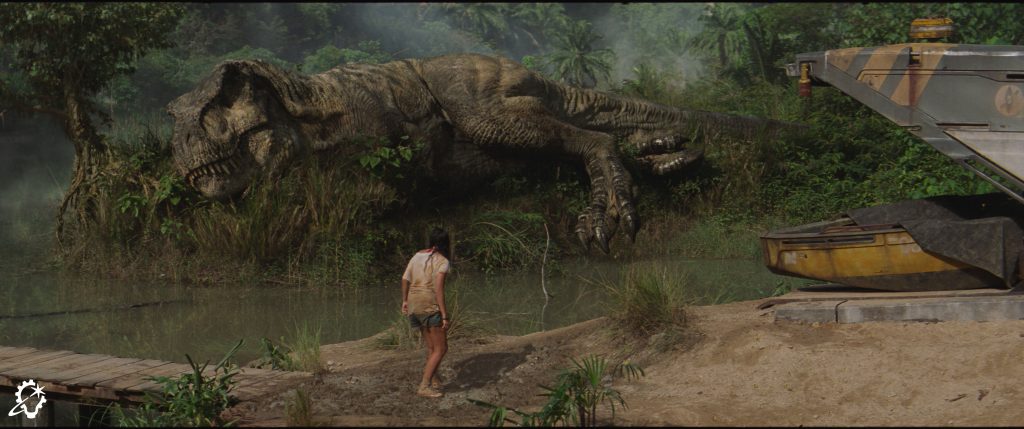
“The T. rex boat inflation scene was an idea Gareth had really early on,” Vickery says. “We looked at it thinking, ‘How do you inflate a raft, have it pop up, and then like a magic trick, make the T. rex vanish?’ On the day, we had a special effects raft that inflated, but it didn’t fit into the bag, so it was laid out and they popped it up, and it inflated and fell into the water, but it didn’t stand up on its end. It took much longer to inflate, so that was always designed to be a reference for us, and then our effects artists worked on that and created this wonderful piece of dynamic simulation that had to be choreographed as a piece of animation to feel naturalistic, slowly dropping into the water. We spent a long time on the simulation of the raft. As a supervisor, that was a thing of absolute awe-inspiring wonder for me. The artist that worked on that simulation did such an amazing job because it’s an incredibly complex piece of dynamics and timing. We ended up with a subtle piece of animation where, just as the raft is inflating, you start to see the T. rex moving and start to get up.”
Bringing this adaptation of a classic Jurassic scene from the pages of the novel to the big screen required some ingenious thinking, especially given the presence of a sleeping T. rex and a noisy inflating raft.
“We played around with the T. rex a number of times because we had to walk a very thin line,” notes Vickery. “If you thought the T. rex was awake, you’d wonder why it didn’t see the girl and eat her, so it had to look like it was asleep, but not so fast asleep that it wouldn’t have the ability to wake up and move off.” Timing was everything. This newer version of the T. rex wasn’t as simple as reskinning the existing T. rex asset; this required a completely new “build” taking into account the larger frame and bulk of this Tyrannosaur (to say nothing of its ability to swim). Vickery has nothing but praise for the team that worked on the project.
“The creature department has a brilliant understanding of anatomy; they could be biologists. We had a modeler on Jurassic World: Dominion who trained as a palaeontologist at university, but it’s more than just figuring out how its muscles should jiggle and how its skin should wrinkle. That gets you to the equivalent of a shop mannequin version of a dinosaur. The challenge is to imbue character into the creature, so it feels unique amongst its own species.”
“Gareth would say, ‘I want to see 100 T. rex’s perform and choose the best one,’” Vickery continues. “He wanted the Robert De Niro version, not the shop mannequin, so how do we imbue that kind of character into it? Part of it was to go back to the animation reference, so you really understood the creature’s intent, and part of it was making sure it’s performing in a naturalistic way.
“Gareth explained how, if you block a sequence with an actor and the brief is you come in the door and you sit down at the desk and you pick up the pen, then the person who’s the stand-in for the day will walk in the door and sit at the desk and pick up the pen,” Vickery adds. “But when the actor comes in, they’ll walk in the door and they’ll give him a mean look and they give it the De Niro treatment and you get a real performance. We always look for that level of performance, and that goes all the way back down to the anatomy of the creature. Do you know where its muscles are firing to give tension in the neck or in the legs? Gareth was interested in things that a creature would have that weren’t preserved in the fossil record, so that gave us creative licence to add extra fat layers or muscles, or waddle under the neck or flaps of skin in different places that would help give it character, which the shop mannequin version wouldn’t have had.”
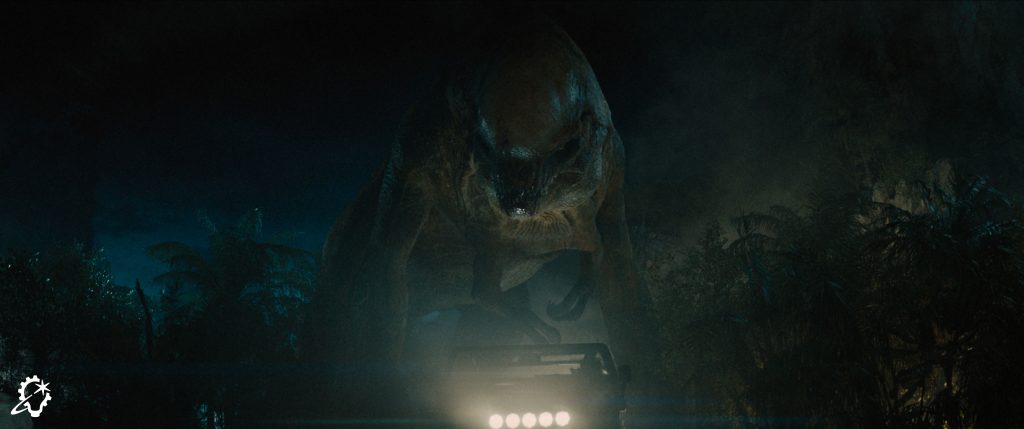
In Jurassic World Rebirth, there’s an extra layer to the story of the dinosaurs; alongside the “classics,” there are genetic mutations, creatures created while striving to find the perfect mix of DNA – both biologically ancient and contemporary – to create the attractions demanded in the parks. As Vickery explains, these creatures were never intended to be seen by the public.
“It’s not like Jurassic World, where they were trying to create attractions for the park. These are failed experiments to create truer genetic dinosaurs. Before they figured out the exact strands needed to get a Velociraptor, they didn’t get the combination right, so that’s how we got the Mutadon. You’re supposed to feel a bit sorry for these creatures. It’s like Sloth in The Goonies [1985], initially terrifying, but then you feel really sad for him by the end of the film, and he becomes a hero.”
Vickery adds with a smile, “I’m not sure you feel that sad for the D. rex, but you do understand that it’s biologically limited. It’s got this huge encumbrance on its head. It’s heavy and weighty, and that means it can’t run really fast.”
In addition to the raft and the T. rex, there are plenty of other visual effects in the river sequence. “When visual effects are successful, people don’t notice them,” says Vickery. “The raft, the grass, the tree, and the land mass that the T. rex was on were entirely digital; it wasn’t shot on location. The thing is, no one’s going to look at it and go, ‘That was a visual effect,’ so it doesn’t get the credit it deserves, and that’s something I think about a lot. When you’re so close to a film and you’re working on every single component of it, you inherently know what’s a visual effect and what’s not. You hope to get to a place where people don’t realize what a visual effect is, but you’ll never fool them with a T. rex, right? It’s hard to know where to place your emphasis when you’re discussing or promoting work, and it’s hard to know where to draw people’s attention because I don’t know what you or the person sitting next to you understand to be visual effects or not.”
Another unseen visual effect is water, of which there is plenty in Jurassic World Rebirth. From the Mosasaurus attacking Duncan Kincaid’s boat to the T. rex attack on the Delgado family (Manuel Garcia-Rulfo as Reuben, Luna Blaise as Teresa, Audrina Miranda as Isabella, and David Iacono as Luna’s boyfriend, Xavier Dobbs), water is a constant presence in the film. And the marriage between the real-world filming locations and the pixels of ILM required some heavy-duty work to succeed, as Vickery explains.
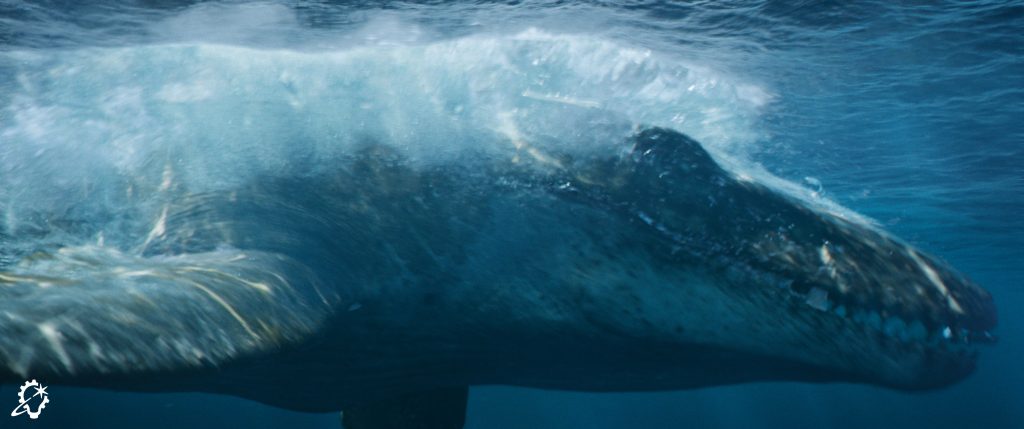
“We spent six weeks in Malta shooting the boat sequence, and the cast were on the water for two days of those six weeks. I took a drone out with the second unit and did aerial photography for another three or four days, so probably 85% of the 300 shots in that sequence were shot on dry land. There are very few shots which don’t have some element of digital water in them, even the shots that were filmed at sea. Perhaps it’s a little more obvious when there’s a huge dinosaur thrashing around in it. But the fact that only 10% to 15% of those shots have real water in them is another thing that audiences may take for granted when they’re watching the film.
“Our effects department, led by CG supervisor Miguel Perez Senent, started development work on the water simulations when we were still in pre-production,” Vickery continues, “so we had a good six months run up to it because there are 50 pages of script that take place on the ocean. So we always expected that to be the biggest technical challenge we had on the entire film.”
That massive undertaking required new solutions to work. “We built new water solvers in Houdini [3D visual effects software] to help with the white water, the spray, and the secondary and tertiary splashes as the creatures break out of the water, but it was a massive data management issue because the simulations were throwing huge amounts of data around. One of the sims had over 5 billion points of white water spray and splash, so Miguel developed some really clever techniques and tools to help us identify and break those simulations up into regions to make the caches and the sims more manageable.”
The technical aspects of the process are groundbreaking, exactly what audiences and followers of ILM have come to expect over half a century of innovation, but the glue that seals the effects to the physical action requires an artist’s touch.
“Beyond the technical side of it, there’s the visual artistry of being able to blend and match the look of water in Thailand, where it’s slightly greenish-tinted water where you can see through to the rocks and the coral beneath the surface, or the slightly deeper, bluer waters of Malta,” explains Vickery. “And then being able to make sure we’re matching all the different lighting conditions that we had throughout the time we were shooting in Thailand and Malta, on the tank, and on the stage, and all the while trying to live up to Gareth’s standards of cinematography and lighting.
“We had John Mathieson on the show, arguably one of the finest cinematographers alive today,” Vickery adds, “so we’re trying to match our work to the best in the world, whether it’s cinematography or special effects. The artists at ILM stand toe-to-toe with all of those departments.”
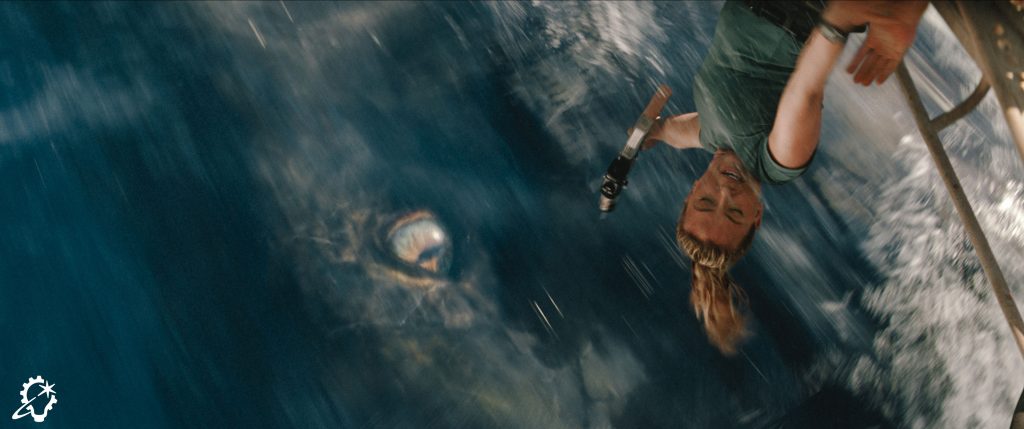
To evoke the look and feel of the 1993 original, Gareth Edwards chose to film Jurassic World Rebirth on 35mm film using Panaflex Millennium XL2 cameras and vintage C and E Series anamorphic lenses from Panavision, closely following the equipment used by Steven Spielberg over 30 years ago. In days past, such a decision could have caused issues, but decades into the digital age, Edwards’s choice was purely aesthetic.
“I’ve gone back and forth between digital and film with the projects that I’ve worked on at ILM and elsewhere,” says Vickery. “Jurassic World: Fallen Kingdom was fully digital, Avatar: The Way of Water [2022] was digital, Mission Impossible – Rogue Nation [2015] was shot on film, and this Jurassic was shot on film, so I don’t really have any skin in the game as to which one I prefer because it’s the difference between painting on a wall or painting on a canvas. There’s a texture that’s unique to film, which I really enjoy. There’s the grain, the emulsion, the chromatic aberration, the distortion, the shallow depth of field. It helps you bed the visual effects into something that feels real. Gareth wanted the aesthetic of the original Jurassic Park, not the narrative or the characters, just the aesthetic. He wanted it to be as if Universal had gone into their film archives and found something they shot 30 years ago. It felt quite nostalgic at times.”
With a career spanning well over two decades and a role as creative director of ILM’s Mumbai studio, one could be forgiven for thinking David Vickery knows all there is to know in his field. But in an arena built on innovation and creativity, he continues to learn from others and add that knowledge to his own, including from Rebirth’s director.“Gareth would say, ‘Don’t be afraid to try new things,’” the visual effects artist concludes. “When we started designing these creatures, his remit was to do little pencil sketches, so if you give him 13 ideas for a dinosaur, he’d be upset if seven of them weren’t so entirely stupid that we couldn’t use them because we hadn’t pushed the envelope far enough. He didn’t want 13 really safe ideas because we would look back and think, ‘What if we’d pushed it a bit harder?’ It’s much easier to dial back something crazy and make it truly excellent than it is to force something average to be ‘good enough.’ The flip side of that is oftentimes on a film you’ll come up with an idea and you push it harder and harder, and you try and try, but it doesn’t work, so it’s also about knowing when you should tear it up and start again. I feel like I learned a lot from Gareth.”
Vickery pauses for a moment. “He did an amazing job on Rogue One, so if he ever does another Star Wars, I’m in.”
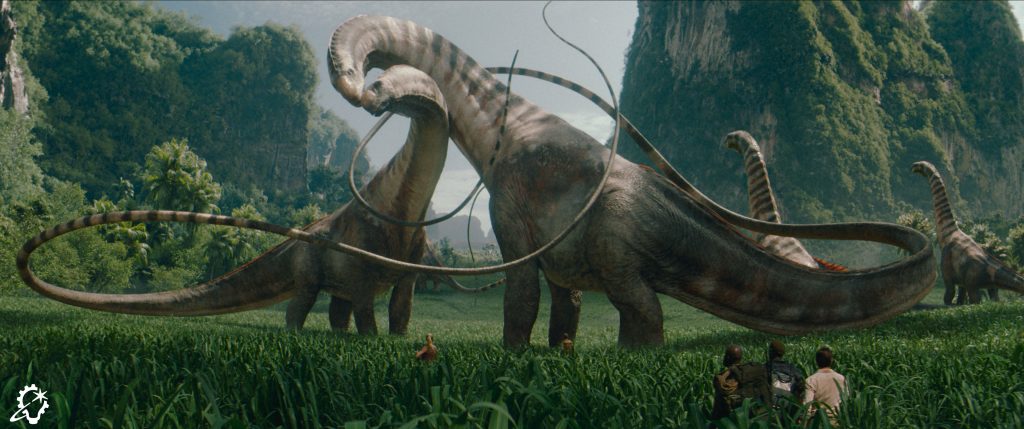
—
Jurassic World Rebirth is available to stream on Peacock beginning October 30, 2025.
Mark Newbold has contributed to Star Wars Insider magazine since 2006, is a 4-time Star Wars Celebration stage host, avid podcaster, and the Editor-in-Chief of FanthaTracks.com. Online since 1996. You can find this Hoopy frood online @Prefect_Timing.